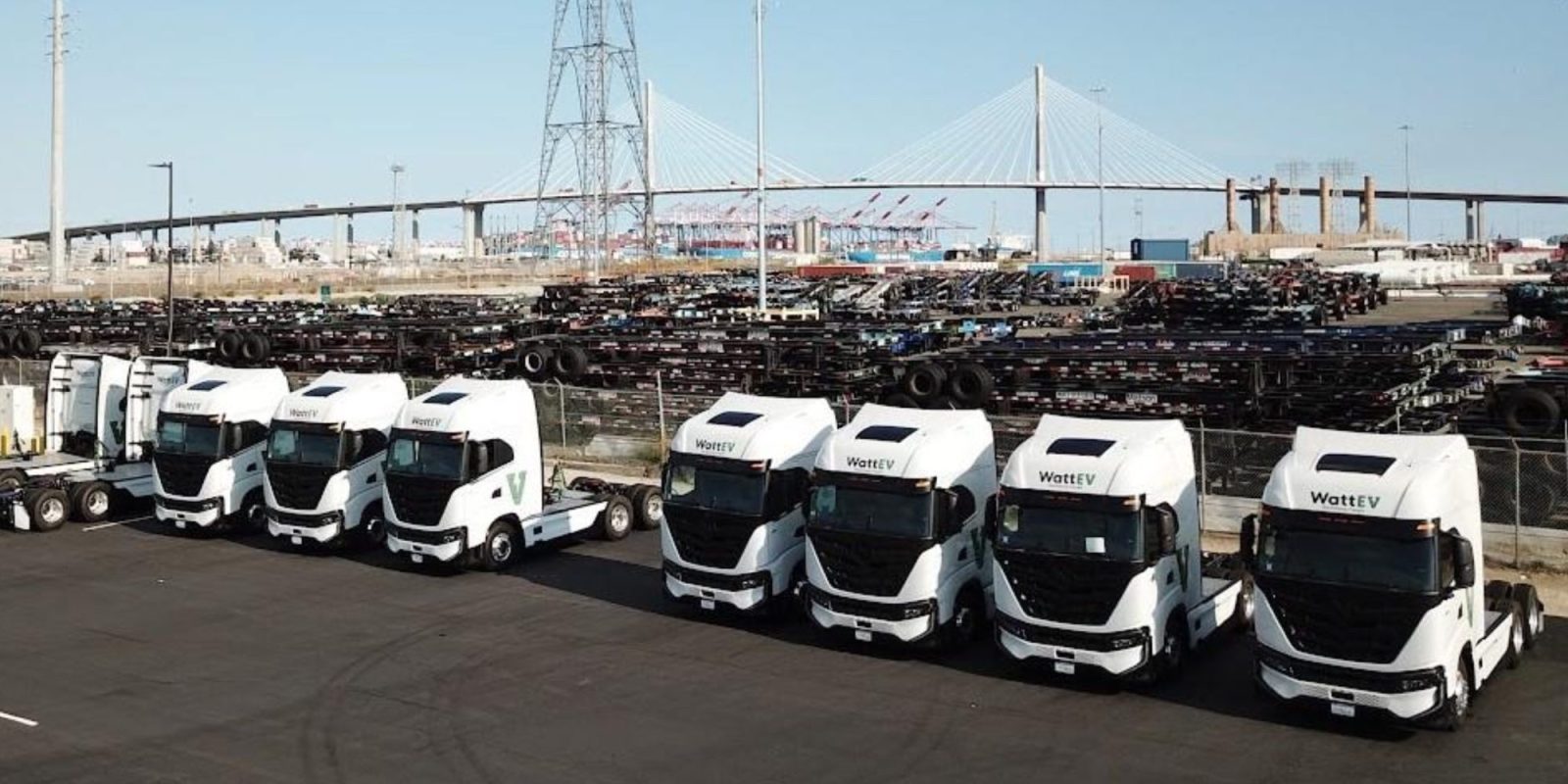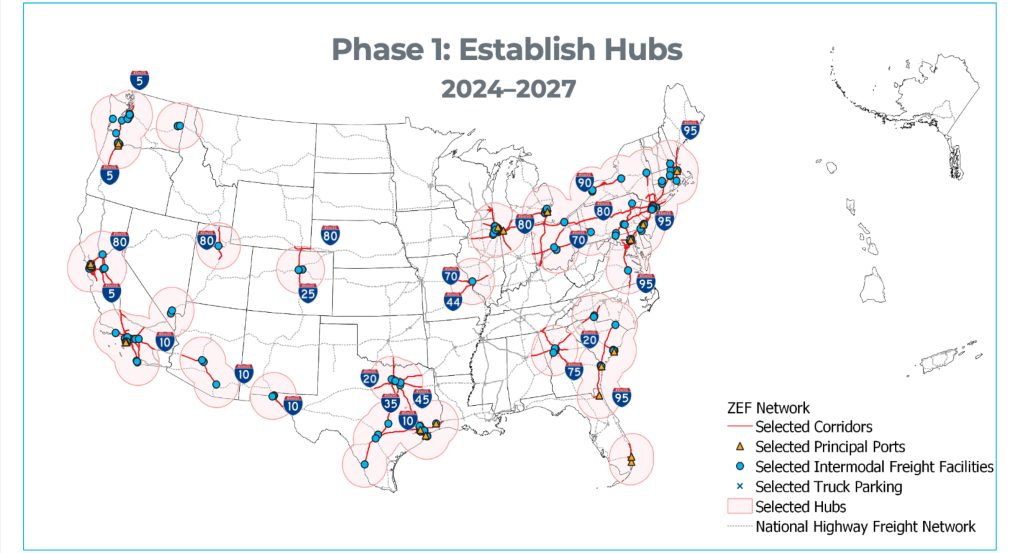Biden admin debuts infrastructure plan to electrify freight by 2040, a first

The Biden Administration has released the first-ever strategy document detailing its plan to target specific freight corridors for infrastructure improvement, with the intent of helping to reach its goal of 100% zero-emission new truck sales by 2040.
The strategy is a cooperation between the Departments of Transportation and Energy (through the Joint Office of Energy and Transportation) and the Environmental Protection Agency. It's the first attempt by the US government to propose a consistent strategy for electrifying freight transport nationwide. The offices analyzed how medium and heavy duty freight vehicles move in America, and established priorities of what routes should be targeted first in order to maximize pollution reductions.
Heavy duty vehicles have a disproportionate effect on pollution, as large diesel engines release many more particulate emissions than light-duty vehicles do. These vehicles tend to drive along specific routes, and those routes often go through poorer communities, with 75% of truck traffic traveling on just 4% of the nation's roads. This means these places experience disproportionate pollution - and that we can get disproportionate gains just by cleaning up a small amount of roads, instead of targeting every road in the country haphazardly.
So this strategy does target those roads first, focusing on certain "transport hubs" between 2024-2027. Those hubs are in the largest areas for freight traffic around the country, and some associated corridors between or near the hubs. For example, the hub around the Ports of Los Angeles and Long Beach and the logistics centers of the Inland Empire, or the Texas Triangle, or much of the Northeastern seaboard where US population density is highest.

These areas are targeted partially due to how much traffic they see, but also other important factors like areas that experience disproportionate air quality burdens, and with a particular interest in states with policies that enable zero-emission vehicle deployment (specifically, California's Advanced Clean Trucks rule[1], which several other states[2] have adopted).
The deployment strategy goes on to connect these preliminary corridors from '27-'30, then expand the network from '30-'35, then complete electrification of the National Highway Freight Network from '35-'40.









The staged deployment also recognizes the limitations of today's technology. Currently, electric trucks are more than capable for certain tasks like drayage and last-mile delivery, but long-haul trucking and sleeper cabs just aren't there yet due to the mass and cost of batteries. So in the short term, shorter and more frequent routes, which also tend to go through the most populated areas, will be targeted first.
These routes also offer the best cost-of-ownership advantages, another factor the plan takes into account. The strategy doesn't just focus on BEVs though, but also acknowledges that hydrogen could help to electrify zero emission heavy duty transport. Due to hydrogen's higher energy density, it could be useful for long-haul trucking.
But infrastructure difficulties are greater with hydrogen, because hydrogen fueling facilities are costly and rare, and there is no nationwide hydrogen distribution network already established, unlike the ones we have for diesel and electricity. So the strategy will help to identify where the best locations for hydrogen refueling facilities might land. This strategy doesn't commit additional money, it merely helps to direct funding, both from government and private sources, into the places that have been identified as the most ripe for electrification.
Billions of dollars have already been committed by the federal government largely via President Biden's two signature legislative accomplishments the Bipartisan Infrastructure Law and the Inflation Reduction Act. In addition, there is additional funding from state governments, and just two weeks ago the EPA committed £3 billion towards cleaning up ports[3] (there's a webinar about this plan's funding opportunities tomorrow from 2-4PM EDT[4]). The full strategy (with ~300 pages listing corridors and port facilities) is available here[5].
Electrek's Take
In our recent conversations at events related to heavy duty trucking (e.g. truck charger openings[6], ACT Expo[7], municipal truck ride&drive events[8], etc.), infrastructure is the main topic of conversation.
A few years ago, fleets were curious about how EV trucks might be able to fit into fleets like theirs, but things have moved rapidly and now everyone is rushing to install chargers at their depots, or wondering what sort of public charging infrastructure they might be able to find[9]. Regulators are trying to find ways to streamline these installations, as some of them can be held up and make it difficult for trucking companies to electrify as quickly as governments want them to[10]. So a directive from the federal government about how to achieve these goals will give a lot of entities more clarity on how to get where we need to be, and on what to target first.
There's no reason to install a huge charging station in Sterling, North Dakota[11], right now if we can instead target the trucks handling a combined ~20 million TEU on the 710 in Long Beach[12]. And apparently this was a pretty big deal, since we got comments from every environmental organization you can dream of about this new strategy. The Sierra Club, BlueGreen Alliance, Environmental Defense Fund, International Council on Clean Transportation and more all sent us statements praising the new strategy.
As one final note, as a Californian, I particularly like the shoutout to "states with policies that enable ZEV deployment," namely California and the states that follow our heavy duty ZEV rules.
In many ways our aggressive zero emission truck rules have set the bar nationally, and proven viability of these strategies in a state with lots of roads and which enables a lot of America's trucks commerce (through its two largest container ports).
I love that we're leading the way on this and that the Biden Administration seems to be rapidly taking up the banner (and we're doing pretty well on the light-duty side too[13]).
FTC: We use income earning auto affiliate links. More.[14]
References
- ^ California's Advanced Clean Trucks rule (electrek.co)
- ^ several other states (www.electrictrucksnow.com)
- ^ committed £3 billion towards cleaning up ports (www.epa.gov)
- ^ webinar about this plan's funding opportunities tomorrow from 2-4PM EDT (www.epa.gov)
- ^ available here (driveelectric.gov)
- ^ truck charger openings (electrek.co)
- ^ ACT Expo (electrek.co)
- ^ municipal truck ride&drive events (electrek.co)
- ^ public charging infrastructure they might be able to find (electrek.co)
- ^ as quickly as governments want them to (electrek.co)
- ^ Sterling, North Dakota (maps.app.goo.gl)
- ^ the 710 in Long Beach (www.pbssocal.org)
- ^ doing pretty well on the light-duty side too (electrek.co)
- ^ More. (electrek.co)